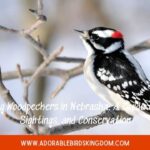If you’re like me, you’re fascinated by the diverse wildlife that calls Montana home. Among these creatures are a variety of owls, each with unique characteristics and habits that make them intriguing to observe. In this blog, we’ll delve into the world of Montana’s owls, exploring their habitats, behaviors, and the roles they play in the ecosystem.
Did you know Montana is home to more than a dozen owl species? From the diminutive Northern Pygmy Owl to the formidable Great Horned Owl, these nocturnal raptors are as varied as the Montana landscape itself. Stay tuned as we embark on this exciting journey, learning more about these remarkable birds and their lives in the Big Sky Country.
Overview of Owl Species in Montana
In Montana, the skies are alive with a population of fascinating owl species. Diverse in size, shape and behavior, there are over 15 unique owl species that call our state their home.
One of the smallest inhabitants of Montana’s nighttime skies is the Northern Pygmy Owl. Measuring a mere 6 to 7 inches in length, don’t let this bird’s small stature fool you, it’s a tenacious hunter. They’ve got a taste for songbirds, but they’re not shy about taking on prey twice their size.
Next in line is the Burrowing Owl. Unlike most birds, this owl prefers ground-dwelling, making its home in burrows on the prairie, marking a unique presence in Montana’s ecosystem. When these owls are active, they can be spotted perched near their burrows, bobbing in a distinctive way to ward off predators or declare its territory.
Our owls range in size all the way up to the Great Horned Owl, an intimidating creature known for its feather plumage which resembles horns. They’re not just visually impressive but also powerful predators that can take down birds and mammals larger than themselves.
Each owl species plays a crucial role in maintaining the health of Montana’s ecosystems. From controlling rodent populations to serving as indicators of environmental health, these unique species are integral to our state’s biodiversity.
While it’s thrilling to spot these birds in the wild, remember our nighttime avian friends are more than just majestic creatures of the night. They’re vital contributors to Montana’s thriving wildlife community. For anyone wanting to learn more about how these creatures continue to shape Montana’s ecosystem, it’s worth diving deeper into the lifecycle, diet, and mating habits of these nocturnal hunters.
Habitats of Montana’s Owls
Montana serves as home to a diverse range of owl species each figured out to adapt to pretty specific ecosystems. It’s stunning to see how owls, despite being a single family of birds, inhabit such different habitats due to their varying sizes, hunting styles, and dietary preferences.
Starting from the dense forests, you’d find the Northern Pygmy Owl and the Great Horned Owl. The former, though small, is an aggressive hunter preferring montane coniferous forests for finding its prey. The latter chooses to live in deep woods or forests near open fields or wetlands. Being one of Montana’s most common owl species, the Great Horned Owl can adapt to live anywhere from suburban backyards to the untamed wild.
On the other hand, the Burrowing Owl stands out amongst all owl species for one key reason: it’s a ground dweller! Preferring shortgrass prairies and scrublands, these owls aren’t really into perching high on trees. They are found in abandoned burrows of prairie dogs, which are ideal for both nesting and hunting purposes.
Let’s leave forests and prairies behind and visit the outskirts of urban environments. Aren’t there any owls to be seen? Well, absolutely! Owls like the Barn Owl and the Western Screech-Owl have comfortably settled in suburban areas. They nest in tree cavities or man-made structures preferably close to open fields augmenting their hunting grounds.
Hence, it’s evident that Montana’s range of landscapes from wild woods to urban outskirts all accommodate these various owl species. But why is this important? Well, owls hold a key role in the ecosystem by controlling rodent populations. Moreover, their presence indicates the health of the environment. So, understanding where they live, provides clues to maintaining healthy ecosystems in Montana.
Let’s dive deeper into which species you can find in these diverse habitats.
Note:
It’s crucial to remember that the habitats these owls prefer are based on typical choices and owls of the same species can be found in different habitats. Also, their owl habitats can overlap.
Behaviors and Characteristics of Owls
Let’s delve into the fascinating behaviors and characteristics of Montana’s owls that make them efficient predators. The Northern Pygmy Owl and the Great Horned Owl, with their keen eyesight and precise hunting skills, are nothing short of tactical hunters.
Great Horned Owls are known as the tigers of the air. Unrivaled in strength and stealth, these raptors are known to take down prey larger than themselves including skunks and possums. They’re nocturnal and hunt under cover of darkness, slightly before dawn and after dusk. Their hunting instincts aren’t restricted to the forests. I’ve known them to thrive even in the urban outskirts where they adapt to different prey types.
Whereas, the Northern Pygmy Owl, despite being one of the smallest owl species in Montana, is also fiercely predatory. These birds hunt during the day, employing a sit-and-wait tactic. They’ve got an appetite for songbirds, voles, and large insects.
Switching gears to our avian anomaly, the Burrowing Owl is an asterisk in the owl world. Preferring to roost in burrows on the ground, they add a point of uniqueness among owl species. They are diurnal, meaning they are active during the day. This ground-dwelling behavior possibly influences their varied diet, including rodents, lizards, insects, and even small birds.
The Barn Owl and the Western Screech-Owl found their comfort in nesting in tree cavities or man-made structures. Prowling the nights, they act as the natural pest control, playing a significant role in controlling rodent populations. I’ve noticed they favor areas where there are abundant rodents and insects.
Importance of Owls in the Montana Ecosystem
Owls play a vital role in preserving ecological balance across Montana’s diverse habitats. They’re not just stunning birds to observe, but their presence signifies a healthy environment. How so, you might ask? We’ll dive right in and explore their substantial contributions.
One of the most significant roles of owls, particularly the Barn Owl and Western Screech-Owl, is their natural capacity for pest control. Their diet predominantly consists of rodents and insects, minimizing pests’ population naturally. These owls help protect critical agricultural areas and maintain healthier ecosystems, all the while reducing the need for harmful pesticides.
In line with this, the hunting capabilities of the Northern Pygmy Owl and the Great Horned Owl have direct influences on their environments as well. Their prey choice puts a cap on certain animal populations, vital in terms of forest regeneration and plant diversity. For instance, too many skunks or possums can hinder plant growth. With these formidable hunters on watch, natural balance can prevail.
It’s not just above ground where owls make a difference. The Burrowing Owl, unique for its ground-dwelling behavior, also joins the ecological balancing act, feeding on insects and rodents that live beneath the surface. By keeping the soil-dwelling creatures in check, successful plant growth and nutrient cycling can be maintained.
Finally, owls’ nocturnal behaviors further benefit the ecosystem by providing a diversity of feeding times. Multiple species coexist harmoniously, each having their own time slot to feed, preventing competition for food sources.
As we can see, the owls of Montana, by their very nature, ensure ecological balance and stability. These silent hunters of the night, armed with razor-sharp talons and an all-accommodating appetite, participate in the maintenance and improvement of Montana’s ecosystems, from fields and woods to below ground level. They’re an integral part of the web of life that keeps our environment diverse, balanced, and resilient. So the next time you glimpse into the beautiful eyes of an owl, remember: they’re doing more than just inspecting your presence – they’re maintaining ours.
Conservation Efforts for Montana’s Owl Population
In a bid to protect these amazing creatures and their habitats, numerous conservation efforts are underway. The most significant of these is the Montana Owl Conservation Program. It’s an initiative designed to encourage research and promote public awareness about owls. For those who are not aware, the program facilitates various activities such as owl tracking, nest monitoring, and habitat restoration.
Moreover, organizations such as The Raptors of the Rockies and Wild Skies Raptor Center have dedicated themselves to the preservation of owls. They strive to rescue, rehabilitate, and release injured owls back into their natural habitats. These efforts play a crucial part in safeguarding the Montana owl population.
The state government is also playing its part. Montana Fish, Wildlife & Parks (FWP) has rolled out several initiatives aimed at conservation. One such initiative led to the creation of a Comprehensive Fish and Wildlife Conservation Strategy. It aims to identify species of highest conservation need which includes various owl species.
Notably, these efforts aren’t just restricted to institutions or government entities. Many private landowners have voluntarily set aside portions of their lands for owl conservation under programs like Montana Land Reliance and Land Trusts. They understand that providing adequate habitats for owls and other species is vital to maintaining Montana’s ecosystem health.
While there are still challenges ahead, individuals, organizations, and government bodies have rallied together to make significant strides in protecting Montana’s owls. With concerted effort and continued public support, the hope is that these silent hunters of the night will thrive in Montana for generations to come.
Remember, every species plays a unique role in maintaining the harmony of our shared world. Our efforts to protect and preserve them not only ensure their survival but also pave the way for a healthier, more balanced ecosystem. The much-celebrated efforts to conserve Montana’s owls is a testament to this universal truth.
Conclusion
It’s clear that Montana’s owl population is a priority for many. With the backing of organizations like The Raptors of the Rockies and Wild Skies Raptor Center, the Montana Owl Conservation Program is making strides in research and public awareness. Montana FWP and private landowners are also playing their part, identifying species in need and dedicating land for conservation. Despite facing challenges, it’s these collective efforts that give us hope for the future of Montana’s owls. The focus isn’t just on survival, but on creating an environment where these majestic creatures can thrive. The fight to preserve Montana’s owls underscores the broader importance of protecting all species for a healthier ecosystem. In the end, it’s not just about the owls – it’s about us all.



